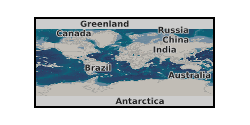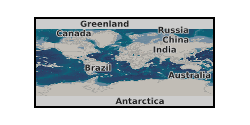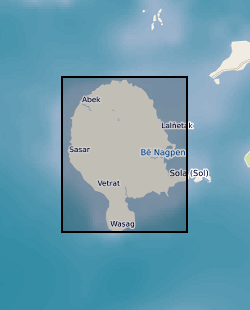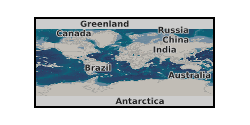Magnetism
Type of resources
Topics
Keywords
Contact for the resource
Provided by
Years
Formats
Representation types
Update frequencies
-

HystLab (Hysteresis Loop analysis box), is MATLAB based software for the advanced processing and analysis of magnetic hysteresis data. Hysteresis loops are one of the most ubiquitous rock magnetic measurements and with the growing need for high resolution analyses of ever larger datasets, there is a need to rapidly, consistently, and accurately process and analyze these data. HystLab is an easy to use graphical interface that is compatible with a wide range of software platforms. The software can read a wide range of data formats and rapidly process the data. It includes functionality to re-center loops, correction for drift, and perform a range of slope saturation corrections.
-

All paleointensity data gathered from the project at University of Liverpool. The data is divided into multiple four letter coded sections which refer to a specific locality and/or experiment type. The sections are as follows: CFEH - Thermal paleointensity experiment on natural clinkers from Montana, USA, looking primarily at the Epsilon Hematite phase, with an additional high-power alternating field demagnetisation step after each infield step of the experiment. LPRM - volcanic material from Kinghorn and Wormit Bay, Scotland (335 and 410 million years old). This was a specific experiment with samples given a prior high temperature applied field of 80 micro Tesla and a pressure remanent magnetisation of 80 micro Tesla. VFSS – a microwave paleointensity experiment carried out on Scottish vitrified fort material, sampled in the 1980s. WTBY – microwave paleointensity experiments carried out on Scottish volcanics from Wormit Bay. Sampled September 2015. YDSR – volcanics from Yandiniling Dike Swarm, in Yilgarn Craton, Australia, 2.6 billion years old. Sampled Nov 2018. Sampled with Yebo Li from the University of Curtin (Perth) as part of a collaboration, resampling of 16WDS sites from his palaeodirections paper. These were microwave demagnetisation (specimen orientation only) and paleointensities. NERC grant NE/P00170X/1.
-

Thermal and Alternating Field demagnetisation data from Carboniferous-age rock material from Cumbria and the Scottish Borders sampled in 2017. This data is divided into multiple four letter coded sections which refer to a specific locality and/or experiment type. BORD are alternating field demagnetisation results on volcanic material from the Scottish Borders, 330 million years old, sampled in the summer of 2017, carried out by Dr Courtney Sprain. BORR are thermal demagnetisation results on volcanic material from Burnmouth Harbour, Longhoughton Beach, Pease Bay, Joppa Shore, Sugar Sands Bay and Ross Beach in the Scottish Borders, 330 million years old, sampled in the summer of 2017, carried out by Dr Courtney Sprain. CMBR are thermal demagnetisation results on rock material from around Cumbria, 330 million years old, and sampled in Spring 2017, sampled and carried out by Dr Courtney Sprain and Dr Mark Hounslow. CUMB are alternating field demagnetisation results on rock material from around Cumbria, 330 million years old, and sampled in spring 2017, sampled and carried out by Dr Courtney Sprain and Dr Mark Hounslow.
-

All the raw experimental data obtained for the study reported in Hodgson, E., Grappone, J. M., Biggin, A. J., Hill, M. J., & Dekkers, M. J. (2018). Thermoremanent behavior in synthetic samples containing natural oxyexsolved titanomagnetite. Geochemistry, Geophysics, Geosystems, 19. https://doi.org/10.1029/2017GC007354
-

The files contain backscattered (BSE) SEM images and photomicrographs of studied samples form Vanua Lava, Vanuatu (New Hebrides). The samples are mantle xenolith found in situ in lava boulders.
-

Nanoscopic (50 < size < 150 nm) magnetic particles embedded within the unaltered interior of mineral crystals like zircons (ZrSiO 4 ) make ideal candidates to record the information about the earth's magnetic field (geodynamo). Information regarding the magnitude of the field can be obtained by measuring the natural remnant magnetization (NRM) of these carriers and further information on the approximate size range of the carriers can be obtained by carrying out thermal remnant magnetization measurements (TRM). However very little is known about the actual morphology and spatial distribution of these carriers in order to understand the fundamental parameters influencing paleomagnetic recording. We propose to image pristine zircons crystals with simple geological histories containing large remnant magnetization using ptychotomography in order to investigate the size, shape and spatial distribution of nano-paleomagnetic carriers. This would also give us an opportunity to fine tune the ptychotomographic setup at I13-coherence branch. This data package consists of 3D maps of Bishop Tuff Zircons, relatively young. The folders contain a stack of .tiff files which can be loaded into imagej, dragonfly, aviso for segmentation purposes.
 NERC Data Catalogue Service
NERC Data Catalogue Service